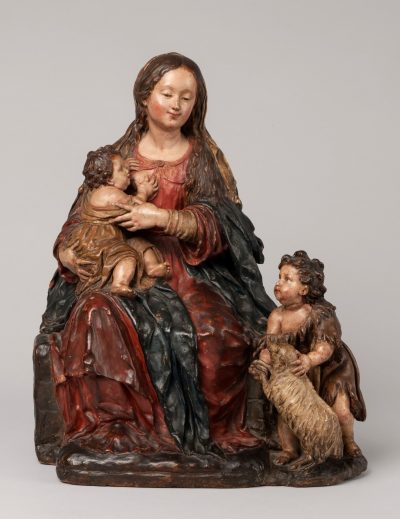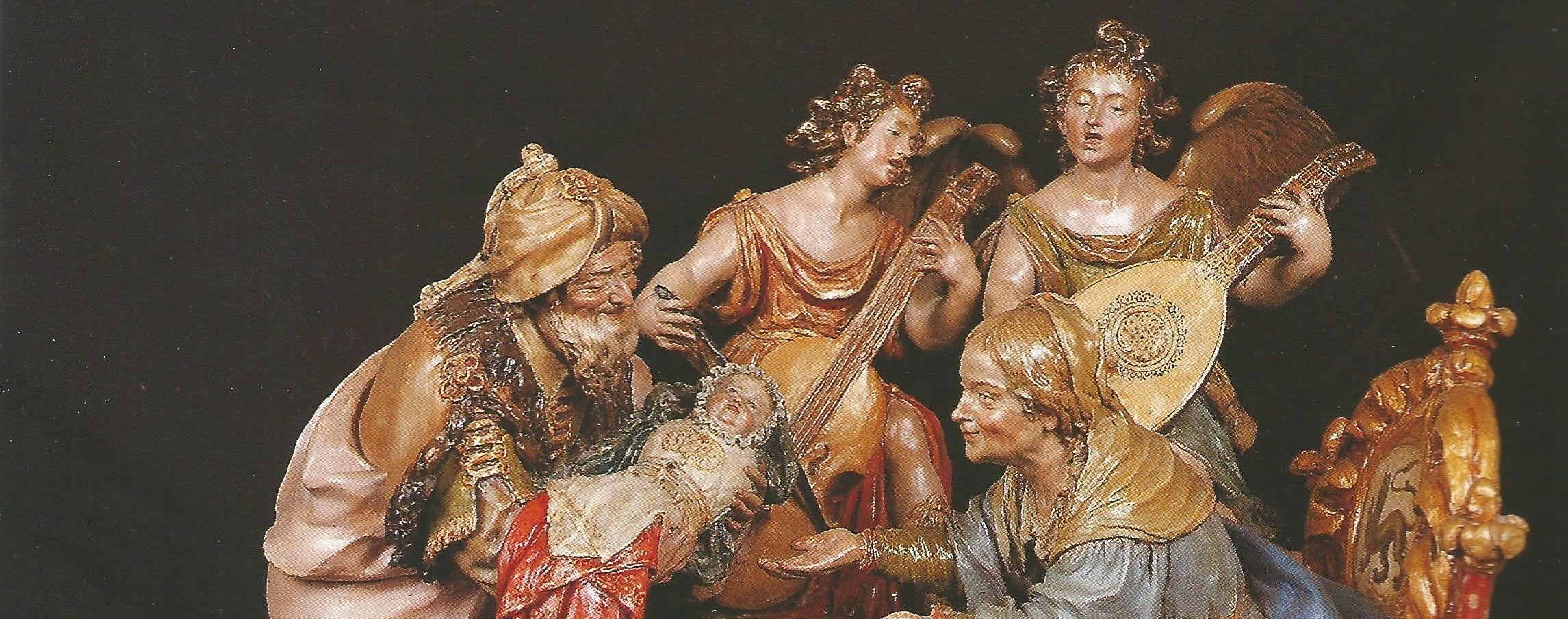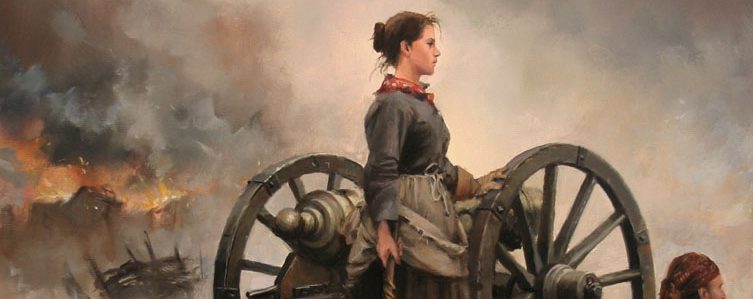Source:Sonrisas en el camino
The language of sculpture
The famous Renaissance artist, Michelangelo Buonarrotti, on finishing his most realistic work, Moses, looking at it carefully and overwhelmed by the expression on his imposing and magnificent face, struck him on the right knee and asked him: “Why don’t you talk to me?”
Sculpture, according to John Ruskin, “is not the mere carving of the form of a thing, but the sculpting of its effect” and that is what Luisa Roldán, La Roldana, did with her sculptures, endowing them with realism, effect, passion and humanism on all four sides. A forerunner in her art, a pioneer and a genius of the Baroque.
Luisa Roldán, the great artist

Luisa Roldán. Virgin and Child with Saint John the Baptist. Between 1689 and 1706. Earthenware and polychrome 41,5 x 33 x 25,5 cm. Inv. No. CE2966
And it seems that Luisa is regaining the prominence she had and was not recognised. Recently the press reported that the Andalusian Regional Government’s Department of Culture and Historical Heritage had acquired the relief “Virgen de la Leche” by “La Roldana” for the Museum of Fine Arts in Seville, thus adding to its collection a work by the Sevillian Baroque artist, which was only represented by a head of the infant Saint John the Baptist.
Wooden sculptures to engage in conversation, to talk to them, to be closer to the people. And all following the canons of the Council of Trent, which gave guidelines to humanise the art of images and to bring religion closer to the people.
Luisa Ignacia Roldán Villavicencio was born in Seville on 8 September 1652 and was the first registered Spanish sculptress and the first at the Spanish court. She was one of the leading figures in Baroque sculpture in Andalusia between the end of the 17th century and the beginning of the 18th century. Her fame was so great that she was recognised as a sculptor as important as her father, Pedro Roldán.
Ingenuity, mastery and imagination
Luisa was the fifth of 12 children and soon joined her father’s workshop, as she had acquired enormous fame and the workload was considerable. She was not the only one, as it is known that her sister Francisca became a polychromist and her other sister Maria also became a sculptress, as she did. She had a good teacher in her father, a professor at the Seville Academy from 1660.
Ingenuity, mastery from the first strokes of the gouge, imagination and daring to take an increasingly important part in the work of his father’s workshop. It was a workshop that had to be expanded due to the numerous commissions they received.
And there in the workshop, in her place of work and continuous apprenticeship, she became engaged to Luis Antonio Navarro de los Arcos, an apprentice of the sculptor Andrés Cansino. Pedro Roldán opposed the marriage, but his daughter, taking advantage of her father’s workload, agreed to marry her fiancé without parental consent.
With these ingredients for a novel, “the abduction of La Roldana by the apprentice Luis Antonio de los Arcos” took place, as it turns out, in order to stage this marriage without consent, Luis Antonio used the court attorney, Vicente De Ballesteros, to proceed.
The abduction of La Roldana
Thus, the procurator, on behalf of Luis Antonio, taking the petition before the judge of the church, Matías de los Reyes Balenzuela, on 17 December 1671, of wanting to marry Luisa Ignacia Roldán “with whom he had been trying to get married for two years to this part, giving word of marriage to each other and wishing their marriage to be according to the order of our Holy Church”, requested that a bailiff from the archbishopric go to fetch Luisa and bring her before the judge to testify as to the word given.
Several witnesses affirmed that they were present on 15 December, when the word of marriage was given. And on the same 17th December, the bailiff Juan Nieto brought Luisa before the judge. She declared that she was a “young maiden”, that she was not related to Luis Antonio, that she had no vow of chastity and that, despite giving her word to him, she could not fulfil it because of her father’s refusal.
30 March 2020
After the declaration, the judge ordered that the girl be taken to the house of the gilder Lorenzo de Ávila, so that he could “keep her in his power with the necessary custody and guardianship and not hand her over to anyone without a licence and court order”. A similar declaration was made by Luis Antonio. And finally, on 25 December 1671, in the church of San Marcos, the marriage was celebrated with numerous witnesses, but without the bride’s father.
From Seville to Cadiz
As a result of the marriage, with several moves behind her and at only 19 years of age, Luisa began a prolific sculptural production in this first period in Seville. Her husband was almost certainly in charge of the polychromy of the sculptures which, for the most part, have remained anonymous or signed by him, as a woman could not sign a sculpture in those days. It was probably at this stage that her relationship with her father improved, as there are records of various collaborations.
After this first stage of apprenticeship and first works in Seville, in 1686 she moved to Cadiz to carry out various sculptural works commissioned by the cathedral chapter, specifically “figures of Patriarchs and angels for its Monument”. And while in the capital of Cadiz she was commissioned by the municipal deputies to make the sculptures of San Servando and San Germán, which were to be exhibited in the chapter house of the city’s Town Hall.
During her stay in Cádiz she produced numerous sculptures for the city and towns in the province. Images for processions, saints to be venerated, the Mother of Sorrows, the Holy Family and representations of the Infant Jesus. Such was the prestige and the mark she left on the province that on 23 April 2016, the Puerto Real Town Hall named a square after the “artist Luisa Roldán”.
Chamber Sculptress at Court
Towards the end of 1688 or the beginning of 1689, Luisa, together with her family, decided to move to Madrid, seeking official recognition and a better economic situation. This is known because her daughter, María Bernarda, was born in Madrid in February 1689.
With small commissions from nobles and potentates, the family survived while waiting for King Carlos II to appoint her as his chamber sculptress (she had the protection and patronage of Cristóbal de Ontañón, the king’s valet), and this appointment came on 15 October 1692.
And although she gained prestige (she signed her name as “Chamber Sculptress”), the economic situation did not change (her work was poorly paid or she was not even paid at all; there was a brutal crisis in the kingdom) and she had to do private work to survive. In order to relief the family’s dire situation, her husband even applied to be her assistant, but this was not granted.
27 January 2021
When Carlos II died, Luisa fought unspeakably for the new monarch, Felipe V, to reappoint her as chamber sculptress, asking for a house to live in and a rations to support herself and her children. Thus, in October 1701, she was again granted the appointment. In spite of all her works, her prestige and the fact that she was a sculptress of the chamber, shortly before her death on 10 January 1706, she made a “declaration of poverty”.
A great sculptural legacy
I am not going to dwell on the innumerable works she has spread all over the world, in the best museums and collections. Her legacy is great, because of the sculptures of imagery that he has left us, as well as small-format terracottas. She was a great specialist in Nativity scenes, reliefs, nativities, Children of God, angels, Mothers of Sorrows, various saints, Jesus of Nazareth and a large sample of sculptural groups that showed her enormous mastery. I invite you to take a closer look at her figure and to seek out the marvellous work of Luisa, La Roldana.
May this article serve as recognition and admiration for her.
Share this article
On This Day
- 1528 Prince Felipe is sworn as heir to the Spanish kingdoms in Madrid.
- 1593 The city of San Salvador de Jujuy (Argentina) is founded by Francisco Argañaraz y Murguía.
- 1776 Battle of Lexington and Concord (United States).
History of Spain
26 August 2020
27 January 2021
Communism: Now and Then
23 December 2022
28 July 2021








